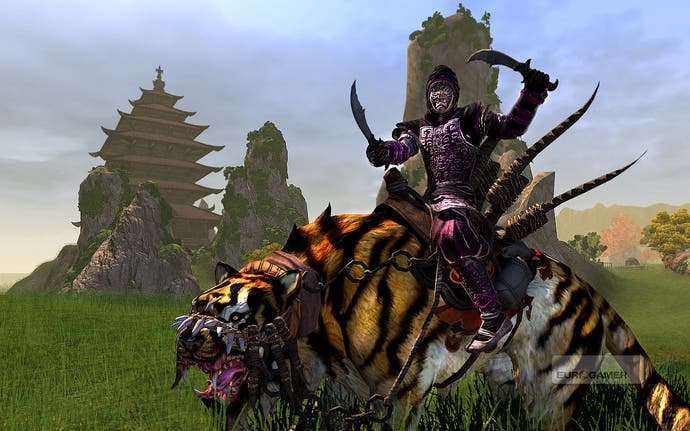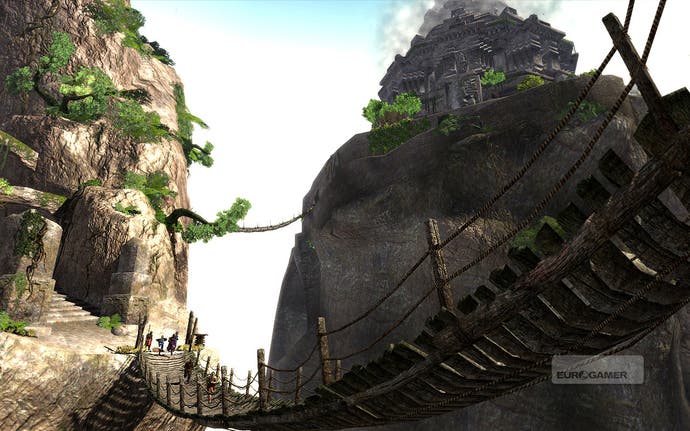Age of Conan: Rise of the Godslayer
The fall and rise?
The Difficult Second Album has become part of rock lore; that awkward moment when a group of musicians, having finally got to tell the world who they are for the first time, have to prove that they have anything more to say. MMO developers (most of them frustrated rock stars, going by the proliferation of dodgy house bands at their conventions) know their pain; they face the Difficult First Expansion. In fact, it's worse, for them, because their first work isn't just a potent memory. It's still there, attached to the expansion, warts and all, and the contrast - whether favourable or otherwise - can be uncomfortable.
Funcom's task in expanding Age of Conan - with Rise of the Godslayer, revealed for the first time at gamescom this week - is even more difficult than most. Here is a game that was considered unfinished at launch, stretched far too thin over its 80 levels, and despite some admirable efforts to flesh it out in recent updates it's still a little on the slender side. In this case, the standard tactic of layering more of the same on top with a raised level cap won't cut it. In fact, it would just make matters worse.
It's to Funcom's credit, then, that its developers have realised this and thought laterally. There's no raised level cap in Rise of the Godslayer. There is a new continent, the Asian-themed Khitai (which comes with a new player race, the Khitan), but it contains lower-level content - for level 20 up - as well as a high-level challenge. There are no new classes, and no more levels, but there is an alternate advancement system that will broaden the range of each existing class as well as increase its power. There isn't just more stuff to do, but there's a greater variety of it; raising wolves and tigers from cubs to fighting companions to mounts, taking sides in factional struggles.

In short, Rise of the Godslayer expands Age of Conan horizontally, not vertically. It puts some much-needed meat on the old barbarian's bones. Game director Craig Morrisson doesn't quite put it like that, of course, but he agrees that the point is to make the whole game, not just the new content, better - and he's keen not to face the age-old expansion problem of making what's gone before suddenly meaningless. "With expansions there's often the feeling of breaking things up, and running the risk of having players become 'detached' from the original setting," he argues. "We didn't want all the great high-end content we have now, and have been building, to be instantly negated by their first few days of exploring in the expansion."
That said, most players will probably be diving into Rise of the Godslayer one of two ways: starting a new Khitan character, or heading straight for Khitai with their level 80. In the former case, you'll still play through the original game's Tortage slave-town story arc - with "a few changes here and there" - up to level 20. Then, whether you belong to the Khitan race or not, you'll be able to head east, towards Robert E. Howard's version of ancient China, the Empire of Khitai. The steppes of the Gateway to Khitai provide level 20-40 adventuring, and lead players up to the Great Wall. But not beyond it.

To get beyond the Wall and into Khitai proper, you'll need a high-level character. Morrisson says he's aiming for the first playfield within the Empire to be playable from "the high 70s through to 80". Beyond that, levels cease to matter, but it's not like there's no progression - the content will get harder, and require the new advancement points to be earned and spent on new abilities. "Once players start to move through they will have to have invested some into the alternate advancement system in order to progress further," Morrisson says. "Skilled and experienced high-level players might even find it possible to start exploring the second of the playfields early on, but they will of course be earning advancement points as they go along."
Once in Khitai, players will - in the suitably pulpy exclamations of Funcom's PR - "descend into the shadows that have fallen over Khitai, the fabled empire of the east! Ride across the grassy steppes and see the purple pagodas of Paikang rising from the vine-choked bamboo jungles! Unravel the corruption that threatens to taint the very heart of this beautiful land forever!"


.png?width=291&height=164&fit=crop&quality=80&format=jpg&auto=webp)




.jpg?width=291&height=164&fit=crop&quality=80&format=jpg&auto=webp)
